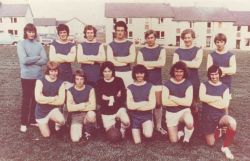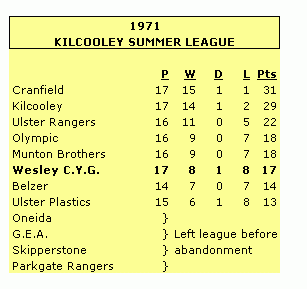Fnendlies
against a couple of local Boys Brigade sides followed and the entire
venture was proving to be such a great success that it was decided
to enter a team in the Kilcooley Summer League which was held for
the first and only time in the summer of 1971.
Until they entered this League, the players had used their own playing
kit with no uniform colour scheme. With competitive football imminent,
it was decided that they should try and standardise their kit by wearing
white school P.E. shirts, white shorts and blue socks; this decision
was based on the fact that the majority of players attended Bangor
Grammar School.
All the worlds major football teams are easily identified by their
Club colours. At International level for example Northern Ireland
wear Green & White, while at European Level the likes of A.C.Milan
are recognized by their Red & Black stripes. In the English League,
Manchester United wear Red & White, Liverpool all Red while Spurs
play in White & Navy. The two big Clubs in Scottish football have
their famous Blue & White kit (Rangers) and Green & White
hooped shirts (Celtic).
In Northern Ireland, Linfield have their Blue & White, Glentoran
their Green, Red & Black, and of course Bangor F.C. wear Yellow
& Blue. Most of the Clubs at Professional and Semi-Professional
level have their own unique kit, usually supplied by a big name manufacturer
who can charge premium prices for replicas.
At Junior Football level, funds are scarcer commodity and Clubs can
rarely afford to purchase kits at the higher end of the price range.
The trend has been to buy kits from a number of manufacturers who
serve this end of the market. In order to keep costs down, these manufacturers
usually only have a small range of designs in the latest colour combination
fashion. This has led to the situation where many Junior Clubs wear
the same design of shirt and change colours with each new kit.
As the bulk of the Wesley Centenary team were Bangor supporters as
well as being pupils of Bangor Grammar school, it was only natural
that they would ideally have preferred in the Yellow & Blue colours
common to those two institutions. Unfortunately, it seemed unlikely
that those wishes could be fulfilled as the team had no funds whatsoever
to purchase even a set of shirts.
The only way of having all the team kitted out in the same colour
was to have all the players wearing white. The logic behind this was
that most players would have white P.E. shirts from school and those
who didn’t could acquire a white “T” shirt relatively
cheaply.
Putting this theory into practice was not altogether successful as
a wide variety of shirts were worn, some of which were so heavily
patterned that they could barely be classed as white.
As the use of assorted white shirts was not going to be a viable proposition,
it became obvious that the Committee running the team were going to
have to beg steal or borrow a set of football shirts.
For their first competitive match in the 1971 Kilcooley Summer League,
the side were given a loan of a set of shirts by the host team, Kilcooley.
These were a set of Red rugby jerseys with white collars that were
made of heavy cotton and proved to be impractical for playing in the
hot summer evenings. BANGOR F.C. TO THE
RESCUE
Having suffered the ignominy of borrowing this Red kit twice, Epworth
reverted to wearing assorted White with the hope that something
would conic their way. In early May, their prayers were answered
when a contact delivered a bag to one of the Committee member’s
house. When opened, it was discovered that the bag contained a set
of used jerseys that had been donated by Bangor F.C.
The body of the shirts was Royal Blue and the round collar, sleeves
& cuffs were Yellow. The shirts were manufactured by the famous
sportswear firm Umbro and were from their famous Aztec range which
had been introduced in the World Cup held in Mexico the previous
year. Although made from “Tangeru” Cotton, the shirts
had worn extremely well, being in extremely good condition.
|
| Epworth Hall
wore their authentic, not “replica”, shirts with pride
for the duration of the summer league, only having to change once
back to the Kilcooley Red for a match where the colours clashed
with their opposition.
For the first two matches of the League, however, a loan of a set
of jerseys was secured from the Kilcooley football team and thus
the team played it’s first competitive match on7 April 1971,
against Oneida, in red jerseys with white collars.
The team which suffered a heavy 7 v 0 defeat on that evening was
Ian McRitchie, Paul Barr, Nigel Jeffers, Jimmy Kennedy, Roy French,
Brian Balrner, Roger Grant, Peter Vannucci, Norman Green, Nicky
Davidson, Roy Richardson and Michael McBride. It is interesting
to note that no less than 9 of the members of that side were schoolmates
at Bangor Grammar School and only 3 players who played in the augural
match in the Kilcooley League were still in the team when it played
it’s last match just over three months later.
The team than reverted to it’s all white colours until their
match against Munton Brothers on 8 May when they were able to wear
an old set of their jerseys donated by local Irish League Club,
Bangor F.C. These were the Royal Blue shirts with Yellow sleeves
which Bangor F.C. had worn the season before winning their first
ever senior trophy, the County Antrim Shield, the previous year.
As a result of this gesture, the Club adopted, as it’s official
colours, the combination of Royal Blue & Yellow and White. Various
permutations of these colours have been worn down through the years
by all the Club’s sides.
Unfortunately, the Kilcooley League did not prove to be an administrative
success and, after many disputes and controversies, was not completed.
However this did not dampen the enthusiasm for the game and plans
were laid for the coming winter season.
During the July holiday period of 1971, the fledgling Youth Guild
side played the visiting 12th. Edinburgh Boy’s Brigade side
which has been the only occasion to date when the opposition have
been from outside these shores. In fact it would be another 22 years
before any team would even play opposition from outside Northern
Ireland!
That summer also saw an attempt to get a ladies team off the ground
and a friendly was arranged against Plessey Limited from Ballynahinch.
Representing the Youth Guild in a 5 v 3 defeat were Janet Govan,
Gay Wells, Vivienne Dunne, Linda Coggins, Sandra Johnston, Linda
Ray, Heather Bathgate, Susan Dunn, Karen Jeffers, Belinda Davidson
and Amanda Dunne. Unfortunately, although the match was a success,
a ladies side did not prove to be a viable prospect at this time.
The result of the above plans for the men’s side was that
many friendlies were played during the 1971/72 season. These were
against a variety of teams and played mostly on Saturday mornings
as pitches were easier to obtain. This arrangement also made it
easier for the majority of players to attend Clandeboye Park in
the afternoon to support Bangor F.C.
The matches during this season were mainly Boy’s Brigade,
Youth Club or unofficial school sides. One opposition side from
this season worth noting was a group who played at the old council
dump beside Clandeboye Cemetery and called themselves Belfast Road
Rangers. Members of this team later helped form long term rivals
Bangor Rangers.
Back the early seventies the fledgling team were unable to be so
choosey and when a set of jerseys was required for the girls of
the Youth Club, the most appropriate were a set of “seconds”
which were being sold off cheaply in S.S. Moore’s sports shop
in Belfast. These were Brazil style Yellow shirts with Green round
collars & cuffs.
Although there was no Blue on the shirt, their colours could be
excused as they were those of the Methodist Church who provided
the funds for their purchase. Being of a medium size and made of
cotton, these shirts shrank after a few washes and, although the
Girls did not make much use of them, they were not practical for
regular use by the Epworth Hall side. Despite the lack of regular
use, these shirts became the first official change kit of the team.
As the Yellow shirts shrank, there was an increasing urgency to
secure a reasonable set of jerseys for the 2nd. XI which was in
the process of being formed. By the time the 2nd. Xl played their
first match on 17th. April 1972, Epworth Hall had purchased another
sale kit from S.S. Moore’s. This was a Red nylon shirt with
White round collar and cuffs.
Although these shirts did not shrink like the cotton set, they were
tight fitting to start with and they were also very thin which led
to a lot of complaints from the players in cold weather. Despite
these problems, Red became the first registered colour of the Swifts
2nd. XI when they entered the newly formed Down Area League in 1974.
FIRST NAME CHANGE
Around the same time, the organisers of the team were coming under
increasing pressure from the Wesley Centenary Youth Leader who was
objecting to the playing of non-Guild members in the side. The main
target of his objection was Clive Briggs who became the Club’s
Leading Goalscorer in 1973/ 74 and later went on to be the treasurer
of Bryansburn Rangers. Although Clive was a member of the Wesley
Centenary Church, he had refused to join the Youth Guild on a matter
of principle.
As a result of this pressure, the team organisers decided to take
steps to become more independent of the Youth Guild and in March
1972 moved towards the formation of a proper Football Club. Accordingly,
the team changed it’s name to Epworth Hall Y.C. which in any
case was the name by which it was better known.
The senior members of the team formed themselves into a Management
Committee to run the Club and guide it into competitive winter football.
The first Committee of the Club consisted of the following :- Peter
Vannucci (General Manager & Secretary), George Wilson (Treasurer),
Norman Green (Team Supervisor) and Roger Grant (Trainer).
One of the first matches under their new name was against their
Epworth Hall neighbours, 2nd.Bangor O.B. and this was followed by
their first participation in Bangor Summer League football. During
the seventies this took may guises, with the competitions being
known as the Castle Cup, McCracken Cup and the Helmsman Cup amongst
other titles. Locations also varied with most competitions being
played at the Valentines but some also taking place at the “Bull
Ring” pitch on the Clandeboye Road.
As Summer football was not encouraged by the I.F.A. (Irish Football
Association), teams were also given different names when they participated
and although they were not affiliated to the I.F.A. at this stage,
the Epworth Hall Y.C. was renamed “Centurions” for the
1972 Castle Cup competition. Their interest only lasted for one
match as they were beaten 2 v 0 by Bangor Y.M. II, sorry, the “Colts”,
in the first round. |


